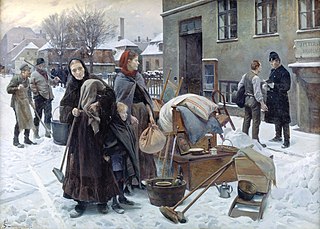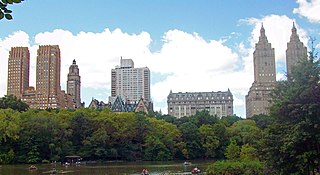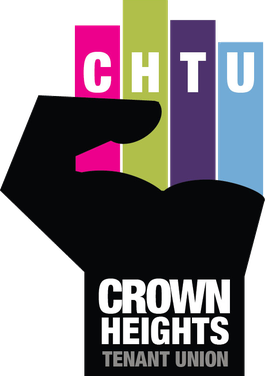Related Research Articles
In the United States, rent control refers to laws or ordinances that set price controls on the rent of residential housing to function as a price ceiling. More loosely, "rent control" describes several types of price control:

Eviction is the removal of a tenant from rental property by the landlord. In some jurisdictions it may also involve the removal of persons from premises that were foreclosed by a mortgagee.

A housing cooperative, or housing co-op, is a legal entity, usually a cooperative or a corporation, which owns real estate, consisting of one or more residential buildings; it is one type of housing tenure. Typically housing cooperatives are owned by shareholders but in some cases they can be owned by a non-profit organization. They are a distinctive form of home ownership that have many characteristics that differ from other residential arrangements such as single family home ownership, condominiums and renting.

Single room occupancy is a form of housing that is typically aimed at residents with low or minimal incomes, or single adults who like a minimalist lifestyle, who rent small, furnished single rooms with a bed, chair, and sometimes a small desk. SRO units are rented out as permanent residence and/or primary residence to individuals, within a multi-tenant building where tenants share a kitchen, toilets or bathrooms. SRO units range from 7 to 13 square metres. In some instances, contemporary units may have a small refrigerator, microwave, or sink.

The Mitchell–Lama Housing Program is a non-subsidy governmental housing guarantee in the state of New York. It was sponsored by New York State Senator MacNeil Mitchell and Assemblyman Alfred Lama. It was signed into law in 1955 as The Limited-Profit Housing Companies Act.
Rent regulation in New York is a means of limiting the amount of rent charged on dwellings. Rent control and rent stabilization are two programs used in parts of New York state. In addition to controlling rent, the system also prescribes rights and obligations for tenants and landlords.
Article 7-C of the New York Multiple Dwelling Law, commonly known as the 1982 Loft Law, was designed to protect the residential tenants of certain former commercial buildings in New York City from substandard conditions, eviction, and unfair rent increases. The law affected buildings it defined as Interim Multiple Dwellings (IMDs), commercial or manufacturing loft buildings that had at least three units occupied by residents during the period of April 1, 1980, through December 1, 1981. It required landlords to bring converted residences up to code, and prevented them from charging tenants for improvements until the issuance of a Certificate of Occupancy. The law was administered by the New York City Loft Board.
Loft Law Amendment is a New York law that created a new window period for recognition of loft tenants that previously did not qualify under the original 1982 Loft Law.
The Real Estate Board of New York (REBNY) is "the leading trade group advocating on policy changes in the real estate industry," a trade association for the real estate industry in New York City. Formed in 1896, its current president is James Whelan.
Housing discrimination in the United States refers to the historical and current barriers, policies, and biases that prevent equitable access to housing. Housing discrimination became more pronounced after the abolition of slavery in 1865, typically as part of Jim Crow laws that enforced racial segregation. The federal government didn't begin to take action against these laws until 1917, when the Supreme Court struck down ordinances prohibiting blacks from occupying or owning buildings in majority-white neighborhoods in Buchanan v. Warley. However, the federal government as well as local governments continued to be directly responsible for housing discrimination through redlining and race-restricted covenants until the Civil Rights Act of 1968.
The Ellis Act is a 1985 California state law that allows landlords to evict residential tenants to "go out of the rental business" in spite of desires by local governments to compel them to continue providing rental housing.
Rent regulation in Canada is a set of laws and policies which control the amount by which rental prices for real property can increase year to year. Each province and territory can pass legislation, where the purpose is to limit rent prices increasing beyond what is affordable for most home dwellers.
Rent regulation is a system of laws, administered by a court or a public authority, which aims to ensure the affordability of housing and tenancies on the rental market for dwellings. Generally, a system of rent regulation involves:

Janet Freeman was an American community organizer and activist for tenant's rights in New York City's lower Manhattan. On June 20, 2013, the corner of Elizabeth Street and Kenmare Street was co-named "Janet Freeman Way" by the New York City Council in her memory and to commemorate her activism on behalf of the community. According to NYC Streets in its listing of street names and their honorees, "Janet Freeman was a community organizer and tenant advocate. She founded the Croman Tenants Association; the Coalition to Protect Public Housing and Section 8; and Co-op Watch, to prevent evictions through phony conversions. She started campaigns to organize tenants against aggressive landlords, phony demolitions, and harassment in and around Chinatown and Little Italy."
The Costa–Hawkins Rental Housing Act ("Costa–Hawkins") is a California state law, enacted in 1995, which places limits on municipal rent control ordinances. Costa–Hawkins preempts the field in two major ways. First, it prohibits cities from establishing rent control over certain kinds of residential units, e.g., single-family dwellings and condominiums, and newly constructed apartment units; these are deemed exempt. Second, it prohibits "vacancy control", also called "strict" rent control. The legislation was sponsored by Democratic Senator Jim Costa and Republican Assemblymember Phil Hawkins.

The Crown Heights Tenant Union (CHTU) is a tenants union created in October 2013 to unify old and new tenants against the gentrification of the Crown Heights, Brooklyn neighborhood. The CHTU has pushed for local collective bargaining agreements between tenants and landlords to be written into the deeds of buildings that would regulate rent increases and codify repair and renovation standards. They also assist individual tenants, educating them on their rights and how to enforce them, lobby in Albany for better rent laws, and participate in direct action, targeting predatory equity real-estate companies they believe to be involved in illegal evictions and harassment tactics.
The 421-a tax exemption is a property tax exemption in the U.S. state of New York that is given to real-estate developers for building new multifamily residential housing buildings in New York City. As currently written, the program also focuses on promoting affordable housing in the most densely populated areas of New York City. The exemption is granted for any buildings that add multiple new residential units, and typically lasts for 15 to 25 years after the building is completed. Longer exemption periods apply in less densely populated areas of the outer boroughs and upper Manhattan.

Eviction in the United States refers to the pattern of tenant removal by landlords in the United States. In an eviction process, landlords forcibly remove tenants from their place of residence and reclaim the property. Landlords may decide to evict tenants who have failed to pay rent, violated lease terms, or possess an expired lease. Landlords may also choose not to renew a tenant's lease, however, this does not constitute an eviction. In the United States, eviction procedures, landlord rights, and tenant protections vary by state and locality. Historically, the United States has seen changes in domestic eviction rates during periods of major socio-political and economic turmoil—including the Great Depression, the 2008 Recession, and the COVID-19 pandemic. High eviction rates are driven by affordable housing shortages and rising housing costs. Across the United States, low-income and disadvantaged neighborhoods have disproportionately higher eviction rates. Certain demographics—including low income renters, Black and Hispanic renters, women, and people with children—are also at a greater risk of eviction. Additionally, eviction filings remain on renters' public records. This can make it more difficult for renters to access future housing, since most landlords will not rent to a tenant with a history of eviction. Eviction and housing instability are also linked to many negative health and life outcomes, including homelessness, poverty, and poor mental and physical health.
The Housing Stability and Tenant Protection Act of 2019 (HSTPA) is a New York state statute that introduced major changes to landlord-tenant law.
Article 7A of the New York Real Property Actions and Proceedings Law (RPAPL) enables that "a housing court judge appoints an administrator to collect the building's rents and use them for repairs" as an alternative to "fruitless rent strikes." About 10% per year of those appointed in the 1980s were removed, and money accountability problems also occurred. This law can also help expedite repairs, such as after a fire.
References
- ↑ Hornick, Sandy (January 1984). "Reusing Industrial Loft Buildings for Housing: Experiences of New York City in Revitalization and Misuse". Washington University Journal of Urban and Contemporary Law . Washington University School of Law. 27: 165.
- ↑ "Residential Re-use of Non-residential Buildings in Manhattan". City of New York, Department of City Planning [and] Mayor's Midtown Action Office. December 1977.
- ↑ Ford, Kristina (1978). Housing Policy & the Urban Middle Class. New Brunswick, N.J.: Center for Urban Policy Research. ISBN 0882850563. OCLC 16731543.
- 1 2 Peck, Jaime (June 20, 2017). "A People's History of NYC's Jeopardized Loft Law". Village Voice . Retrieved April 13, 2018.
- ↑ Lipkis v. Pikus, 99Misc.2d518 ( NY App. Term 1st Dept 1979).
- ↑ Mandel v. Pitkowsky, 102Misc.2d478 (NY App. Term 1st Dept1979).
- ↑ Facciolo, Jay (1986). "Illegal Lofts in New York City: Have the Equities Been Balanced?" (PDF). Fordham Urban Law Journal . 14: 559.
- ↑ Hevesi, Dennis (June 20, 1999). "The Loft Law's Pursuit of Lofty Goals". New York Times . Retrieved April 14, 2018.
- ↑ Shkuda, Aaron (2016). The Lofts of SoHo : Gentrification, Art, and Industry in New York, 1950-1980. Chicago: University of Chicago Press. p. 226. ISBN 978-0226334189. OCLC 920017441.
- ↑ Zukin, Sharon (1989). Loft Living : Culture and Capital in Urban Change . New Brunswick, N.J.: Rutgers University Press. pp. 196. ISBN 0813513898. OCLC 18191048.
- ↑ Wilde, Lisa (February 1984). "Koch's Loft Board Leaves Tenants in Limbo". City Limits . Retrieved April 14, 2018.
- ↑ Rzesniowiecki, Linda; Lebovits, Gerald (2010). "The New York Loft Law". New York Real Property Law Journal. Rochester, NY. 38: 22. SSRN 1539285.
- ↑ Rimer, Sara (November 18, 1983). "Real-Estate War: Tenants vs. Owners vs. The Loft Board". The New York Times. Retrieved April 15, 2018.
- ↑ "2013 Loft Board Report" (PDF). December 2013.
- ↑ Buckley, Cara (November 30, 2010). "Seeking a New Law's Protection, Loft Tenants Instead Find Grief". The New York Times. Retrieved April 13, 2018.
- ↑ Buckley, Cara (July 25, 2010). "That Cheap, Roomy Loft Can Now Be a Legal One, Too". The New York Times. Retrieved April 14, 2018.
- ↑ Peck, Jaime (May 5, 2017). "New York's Loft Law Is In Danger". Village Voice. Retrieved April 14, 2018.
- ↑ Gallaudet, Lisa (December 26, 2013). "New rules governing loft law". Real Estate Weekly . Retrieved April 15, 2018.
- ↑ Sutton, Benjamin (January 18, 2018). ""If Things Were Going Well, We Wouldn't Be Here": Artists Protest NYC's Loft Board". Hyperallergic . Retrieved April 15, 2018.
- ↑ Sutton, Benjamin (April 27, 2018). "Artists and Loft Tenants Protest New York City's Department of Buildings". Hyperallergic. Retrieved April 28, 2018.
- ↑ "City Loft Board Chief Is Appointed by Koch". The New York Times. March 21, 1984. Retrieved April 15, 2018.
- 1 2 Johnson, Kirk (April 19, 1986). "Loft Board Changes Announced". The New York Times. Retrieved April 15, 2018.
- ↑ Hays, Constance L. (March 27, 1990). "Loft Law Keeps Tenants Chic but Not Safe". The New York Times.